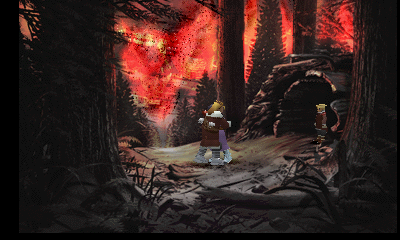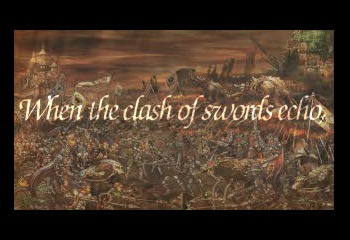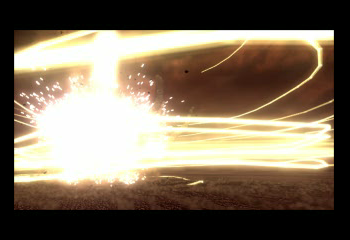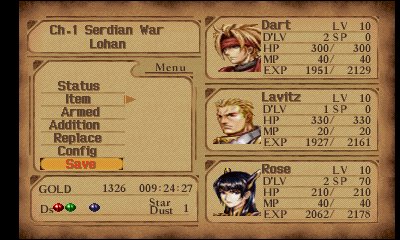The Legend of Dragoon Review by: Zurenriri - 8.7/10
The Legend Lives Forever: A Review of "The Legend of Dragoon"The Legend of Dragoon is a game released in 2000 by Sony Computer Entertainment, for their own system, the Sony Playstation. Released late into the Playstation's life, it was considered at the time to be SCE's grand masterpiece for the system, and was directed by Shuhei Yoshida, who is now president of Sony Worldwide Studios. This game was supposed to be the one that took down Final Fantasy 7, regarded by many to be the greatest RPG on the Playstation and the game that made RPGs mainstream in the west, regarded by some as the greatest RPG of all time, and regarded by few as even the greatest game of all time. Although The Legend of Dragoon had high ambitions and a lot of potential, it was not able to meet its goals or break the records that FF7 set, selling only 280,000 copies in Japan, and just under a million in North America. Let's take a look at the less-than-popular game that would have been, and maybe should have been, one of the best RPGs of its era.
> Graphics <
The game makes use of a few FMVs throughout the story, the first one taking place right after you
select 'New Game'. It shows the town of Seles, the home of the main character, Dart, being destroyed by an invading force. The graphics shown here are of fairly high quality, but the graphics of the first few scenes in the game, including the town of Seles, might not keep a person interested if less-than-stellar graphics were a deal breaker. Of course, any RPG gamer knows that it's not about the graphics, and while the renders themselves are pretty rough, the art is great. Sony obviously had a lot in mind, but the technical limitations of the Playstation didn't allow them to render every single scene of the deep setting that is described on the back of the game's case. Often times you will see any moving objects drawn rather poorly, but the backgrounds will be of excellent quality.
> Sound <
This could also be one of the reasons that The Legend of Dragoon did not soar in as many ways as it could have. The soundtrack for the opening FMV is touching and gets you interested, and the music in most of the towns and areas seems fitting and captivating, but what really holds the game back in terms of sound is the music that they used for the battles. Compared to other RPG games I've played where I'm pumped for a battle as soon as the first few chords are played, The Legend of Dragoon has a weak soundtrack for battles that doesn't get me very pumped at all. Additionally, where other games have different theme songs for each boss battle, The Legend of Dragoon has only three songs that you will hear in combat: one battle song, one boss battle song, and one final song that you will not hear until you are fighting the game's final boss. They really could have stepped it up in terms of quality and variety in this category. The game does make up for it a little bit with the final song you hear at the credits, which put my heart in my chest and really wrapped up the entire story for me in that single song.
> Addictiveness <
A fan of RPGs will want to come back and play this game again and again. I've personally played through it four times, even though I don't typically replay games. The storyline for the game is very linear, as were many RPGs of that era, but there are all kinds of little secrets that you can come back and find later. Perhaps the most challenging is finding all 50 pieces of Stardust, allowing you to fight a "hidden" boss on the fourth disc, before you take on the final boss of the game. Another thing that will keep people coming back is the additions system. It takes a long time, but unlocking the final additions (the ultimate attacks) for each of the seven playable characters (with the exception of Shana who cannot use additions) is very rewarding, almost as rewarding as pulling off the final additions themselves for the first time. This game would be a good candidate for a speed run, since it's fairly easy to remember most of everything that you need to do from start to finish, after a couple of playthroughs.
> Story <
I'm not lying at all when I say that the story for this game unfolds like an epic novel. Starting with only Dart, you learn his story, followed by bits and pieces of the stories of each character you come across as the game progresses. Moments of laughter, sadness, anger, revenge, gratitude, friendship, love, loss, and many other feelings stretch throughout this game and your emotions will change with each task that you complete in this game. Revealing the specifics here would be detrimental to the reader's experience if they haven't played the game, but what I can say is that there are some moments in the game where you can figure out the clues and know what's going to happen, and others where the game will take you completely by surprise and leave you gasping. The only thing that keeps me from rating the story a perfect 10 is the translation from Japanese to English, which at some times can be a bit on the weaker side.
> Depth <
The game is described as having 80 hours of gameplay; my most recent playthrough clocked in at 53 hours, and I prefer to take things pretty slowly. But I would suppose that if you were trying to go for a 100%, or playing with no help from a strategy guide, then the game could take 80 hours, maybe even longer depending on your familiarity for RPG games. A rushed play could probably be done in 30 to 35 hours. But in terms of how deep the game will take you, that is up to the player, but for me, it was not something that could be easily forgotten. I'd be able to rate it higher if there were a few more side quests available, and more difficulty and diversity in the items and equipment that you could find.
> Difficulty <
The game itself is not very hard. Most of the best equipment is practically given to you, and you don't really need to guess on where to go next to continue the story, nearly everything is spelled out for you in black and white. But the reason I rated the difficulty fairly high is because of the battle system, one that drew great praise from some for being so innovative, and great complaints from others who felt that it was too hard to land attacks. I'm talking about the addition system, which involves having very precise timing to land each attack. The beginning attacks only require you to hit the X button once or twice, but as the game progresses on, you unlock more additions that get harder and harder to pull off. Some of them have awkward timing, others, like Dart's Burning Rush attack, require you to be very quick. Each of the final additions require 7 presses of the X button. To throw in a twist, some attacks can be countered at certain intervals with a sudden flash requiring you to press the Circle button. Failing to hit each of the presses with the right timing will result in poor damage, and long, grueling battles. Also, you can't rely on the weaker attacks that require less X presses, especially in the third and fourth discs that have some particularly nasty bosses, because you won't be doing enough damage to survive. One other thing that makes this game difficult is that you can only carry a maximum of 32 items at one time. Stackable items count towards this as well, for example, having 3 Healing Potions counts as 3 items. Throw that in with attack items and all the different healing items, plus the permanent items that you'll discover, and you'll find that your inventory is going to be full throughout most of the game. This is the North American's version of difficulty; I haven't personally played the Japanese version but I've been told that it's even harder.
> Overall <
I've tried my best not to be biased, since some people on this forum already know that The Legend of Dragoon is my all-time favorite video game. I've tried to be fair and point out its flaws as well as its strengths. What draws me the most to a good RPG is the storyline, and this game nails it with that. The game has a unique battle system unlike anything else for its time, and although it leaves things to be desired in terms of its battle music and sprite graphics, it is by all means a game that any RPG fan and any Playstation fan needs to pick up and play if they haven't already. For fans of long RPG series, I'm sorry to disappoint, but this is the only one. Plans for a sequel on the PS2 were announced shortly after the game was released, but it never game to fruition, and Sony formally abandoned the project in 2003, citing that their resources were occupied by other Playstation 2 projects, and that Japanese sales for The Legend of Dragoon were not strong enough to justify a sequel.
> Pros <
+ A completely engrossing story
+ A unique and challenging battle system
+ A long gameplay experience
> Cons <
- Battle audio doesn't really get you "in the mood" for a fight, even against bosses
- Some graphic scenes, particularly the sprites, are mediocre
- Linear path of play with very few side missions and few opportunities to customize your experience
Graphics
7 Sound
6 Addictive
9 Depth
8 Story
9 Difficulty
7


 User Notice
User Notice 







































